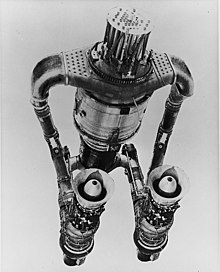General Electric X39
The General Electric X39 is a jet engine that is based on the General Electric J47 , but has been modified for propulsion by means of the heat input from a nuclear reactor .
The reactor heat was given off directly in the reactor core to the air introduced without a heat transfer medium, which drove a subsequent turbine stage and was then passed to the outside via a nozzle. The compressor was driven by the turbine as in the normal turbojet, but no combustion chamber was used and therefore no kerosene was used or consumed, except for starting the engine. Pratt & Whitney's indirect (closed) competing system worked very similarly, but the air was not heated directly in the reactor core, but in a heat exchanger in which a working medium (either liquid sodium or pressurized water) was circulated.
In 1955, as part of the Heat Transfer Reactor experiment with the HTRE-3 reactor, a complete system was tested, consisting of the reactor, the radiation protection shield , a General Electric X39 engine and the complete subsystems. The trials were successfully completed in January 1956. However, the protective shield turned out to be so heavy that it was impossible to operate the entire system in an aircraft. Two X39s could be supplied with the HTRE-3 reactor. Tests were carried out here with high performance.
The theoretical range of a bomber aircraft was given as 48,000 km with a flight speed of 740 km / h.
Due to unsolved technical problems and the successful development of ballistic missiles, the program was discontinued.
literature
- Dennis R. Jenkins: Magnesium Overcast - The Story of the Convair B-36. Specialty Press, 2001/2002, ISBN 1-58007-129-5 , pp. 206-219.
- G. Thornton, B. Blumberg: Aircraft Nuclear Propulsion Heat Transfer Reactor Experiments Fulfill Test Goals. In: Nucleonics. January 19, 1961.
